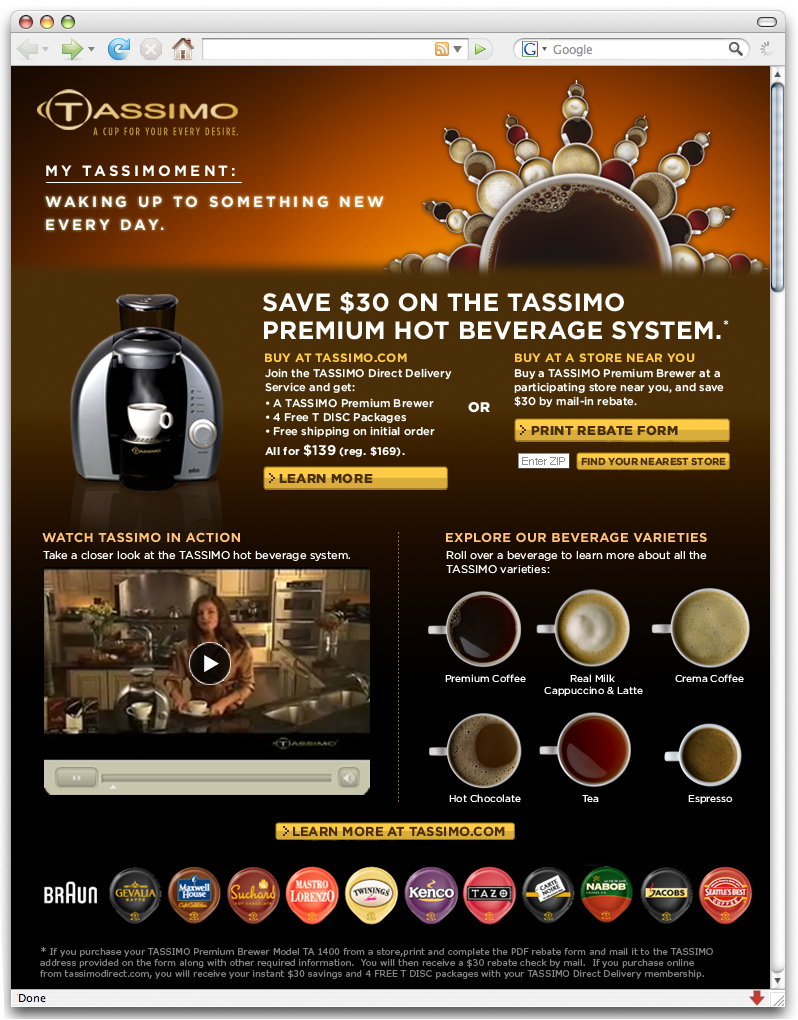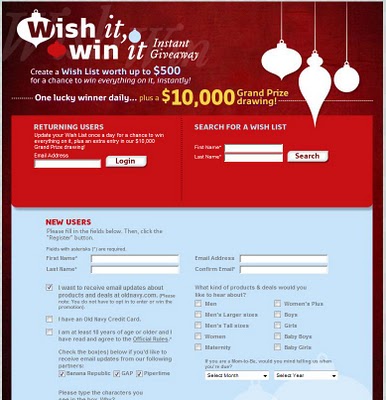Examples of Good Landing Pages
Cat: How to Promote Your Website
Reference and Transactional Landing Page Examples
 This is a bright and clean transactional landing page.
This is a bright and clean transactional landing page.
Directs the user to complete an action. They can only do one thing. It “captures the lead”.
Leading an action is what a landing page is about.

There are many options presented to the user through the use of this “reference landing page”. It does not direct the user to take just one action. It gives the user 6 main choices:
- Buy, or
- Buy at a store near you, or
- Print a rebate form, or
- Find a store near you, or
- Watch a video, or
- Explore varieties, or
- Learn more at their main .com.

This reference holiday landing page is targeted towards 2 types of users forcing them to do one of two actions: “Enter to Win” or “Search for a Wishlist”.
This is a good example of lead generation and targets new and returning users.

Here is an reference landing page (not very pretty albeit) often referred to as a WebVert. The marketing goal focuses on lead generation and interaction with the visitor.
Here a simple “Enter your zip code” field prompts the user to get multiple insurance rates quickly. The next screen would gather more information creating a lead for the company.
What is a landing page?
In online marketing a landing page, sometimes known as a lead capture page, is the page that appears when a potential customer clicks on an advertisement or a search-engine result link. The page will usually display content that is a logical extension of the advertisement or link, and that is optimized to feature specific keywords or phrases for indexing by search engines.
In pay per click (PPC) campaigns, the landing page will also be customized to measure the effectiveness of different advertisements. By adding a parameter to the linking URL, marketers can measure advertisement effectiveness based on relative click-through rates.
Types of landing pages
There are two types of landing pages: reference and transactional.
A reference landing page presents information that is relevant to the visitor. These can display text, images, dynamic compilations of relevant links, or other elements. Reference landing pages are effective if they meet the objectives of their publishers, which may be associations, organizations or public service entities. For many reference landing pages, effectiveness can be measured by the revenue value of the advertising that is displayed on them.
A special type of ‘reference landing page’ is the ‘webvert’, the marketing goal focuses on lead generation and interaction with the visitor. A webvert is not ‘transactional’ in nature. A webvert is a reference based, ethical landing page. The webverts consists of an advert, designed on the AIDA principle. The traffic is driven from Google Adwords and is designed for two specific marketing tactics;
1. To attain high Google Adwords landing page quality scores, the benefit being any Adwords campaign costs are minimized.
2. The webvert has a clear call to action, usually a reply form.
The visitor traffic is immediate as the Adword relies on Google advertising to drive visitors to the webvert.
A transactional landing page seeks to persuade a visitor to complete a transaction such as filling out a form or interacting with advertisements or other objects on the landing page, with the goal being the immediate or eventual sale of a product or service. If information is to be captured, the page will usually withhold information until some minimal amount of visitor information is provided, typically an email address and perhaps a name and telephone number as well – enough to “capture the lead” and add the prospect to a mailing list.
A visitor taking the desired action on a transactional landing page is referred to as a conversion. The efficiency or quality of the landing page can be measured by its conversion rate, the percentage of visitors who complete the desired action. Since the economics of many online marketing programs are determined by the conversion rate, marketers constantly test alternatives and improvements to their landing pages.[1] Some of the testing methods used are A/B testing and multivariate testing.
There is also a third landing page apart from these two above mentioned which is commonly used in Direct Marketing, Squeeze Page. These web pages are very targeted and focus on capturing information about a visitor. These pages have a very high conversion rate and these collect data for an upcoming targeted e-mail or direct contact campaigns.
Search engine optimization
Every page of a site indexed by search engines is a potential landing page.
The goal of search engine optimization (SEO) is to leave few landings to chance. The content of the page and/or links to the page are optimized for very specific, carefully researched keywords and phrases. Those keywords and phrases that are of most value for “organic” or “natural” search engine optimization are those most likely to be used by prospective customers in their search engines. Good choices will cause the site to rank higher in search engine results.
For large websites covering many products or many topics, a single home page cannot be optimized for every topic and still be relevant to all. A different approach is needed, a landing page that will not convert a visitor directly. A “hub” page is optimized for more generic, less targeted keyword phrases that have naturally a lower conversion rate than more-specific search terms. Hub landing pages serve as a “mini portal” within a site – the site establishes a number of virtual home pages, each for a broader topic.[2]